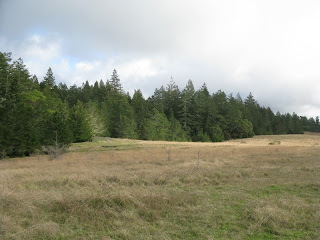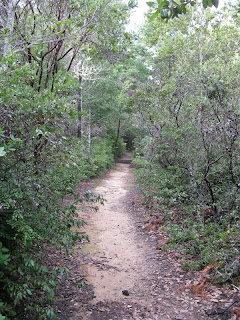However you'll recognize the tell-tale spherical shape of "...golden daffodils, beside the lake, beneath the trees, Fluttering and dancing in the breeze" (Wordsworth's full text here). Minus the lake part, that is, but Filoli has some lovely ponds and pools for the water element.
As you exit the visitor center with your tickets in hand, you have a map of all the daffodil locations in the garden. Look right away on the spot #4 for big pots of Saint Keverne narcissus. They are a deep canary yellow with large cupped flowers. This daffodil is so fragrant! It was intoxicating. It reminded me of some irises. Next to it is the Minnow daffodil, a multi-florets fainter-colored daffodil that smells like a flower honey and that kids should like.
Out in the park and if fragrance-hunting seems like a good game, look for Avalanches and Sugar Cups. They shouldn't disappoint either. The map tells you where to find them.
I started my daffodil stroll by the sunken garden where bold red tulips are already looking good and getting ready for the Spring Fling. Since the weather forecast predicted rain and wind the crowds were few and far between, which wouldn't be the case of a glorious sunny day such as Woodside knows. As I walked along the sunken garden and headed towards the fruit orchards (walled garden), I was attracted by another fragrance that I knew belonged to other flowers. Hyacinthes.
To my left, the garden house was entirely decorated with potted white, purple, and blue hyacinthes, a fittingly seasonal addition to the gorgeous flower bouquets next to the Edwardian pigeon cage - with a live white pigeon in it. Gosh I love it when hyacinthes open up. It means that spring really isn't far. The walled garden had more beds of pink and lavender-hued hyacinthes but pots of swaying daffodils and pink tulips definitely stole the show.
Where in the Bay Area do you get that close to garden perfection in the Western sense of the term? Undoubtedly you will pass countless dedicated gardeners raking, weeding, pulling, and improving what already looks like a jewel of a garden.
So knowledgeable are Filoli's gardeners that they are partnered with University of California Master Gardeners, San Mateo and San Francisco counties. Indeed I had a question about a pink blossoming tall tree and I asked one of the gardeners who told me I was looking at a plum tree.
After you go past the hedge that separates the walled garden from the rose garden, head to the fruit garden which currently resembles a country meadow. A dirt path meanders through a vast green expanse punctuated by yellow dots undulating to and fro at the mercy of the winds. What I liked most in that field was the presence of fruit trees (as winter skeletons, compliments of late February) in the middle of daffodil dreams.
Rather than the orderly potted varieties that grace other areas of the garden, this one seems less tame and wilder - inasmuch as daffodils are ever wild in California. It's a place to frolick, to bend down and touch, to spot oxallis carpetting the ground between the bulbs, to relax. Kids would like to follow the path that in places disappears between stems of daffodils.
 As you continue on the olive walk, notice the white fluffy blooms of the Santa Rosa plum trees. Now turn around the corner and enjoy. You made it to the high place, one of the spectacular sights of this garden. This is a spot where I could spend hours just admiring the architecture of the garden.
As you continue on the olive walk, notice the white fluffy blooms of the Santa Rosa plum trees. Now turn around the corner and enjoy. You made it to the high place, one of the spectacular sights of this garden. This is a spot where I could spend hours just admiring the architecture of the garden.
As the name suggests it is placed on a promontory and the view embraces all the other gardens. By the way, this is one of the spots for the sugarcup daffodils (right by the stairs).
Now retrace your steps in the direction of the house using the middle alley until you hit two square planter boxes with bonzai trees in the knot garden. Look at the design in the box very carefully and then turn around. Both boxes are miniature reproductions of the gardens right behind you, intricate knot patterns in lavender, myrtle, rosemary and barberry. Simply amazing and even more enjoyable when lavender scents fill the air and the hedges textures are accentuated by the summer colors.
Continuing my daffodil tour I made it quickly to the swimming pool (now clouds had turned from grey to menacing) and headed to the west daffodil meadow, probably the biggest daffodil display at Filoli. Again a dirt path slithers through the meadow and you will be able to admire the main building, a brick Georgian revival historic mansion now turned into a museum.
Feel free to take a look at the hills surrounding the estate. From the edge of the field just west of the House, a line of trees marks the edge of the San Andreas Fault and, beyond that, the hills and patchwork of broadleaf evergreen forest, redwoods and chaparral.
 Now if you have children like mine who enjoy nature but other things too, it might be high time to return to the visitor center where you can hit the crafts tables and make daffodil pinwheels, magnets, frames and other daffodil-inspired arts and crafts. Daffodils only last so long and at Filoli so long means three days - until Sunday February 28 at 5pm. Go for it, it's gorgeous and it'll be sunny.
Now if you have children like mine who enjoy nature but other things too, it might be high time to return to the visitor center where you can hit the crafts tables and make daffodil pinwheels, magnets, frames and other daffodil-inspired arts and crafts. Daffodils only last so long and at Filoli so long means three days - until Sunday February 28 at 5pm. Go for it, it's gorgeous and it'll be sunny.
As the name suggests it is placed on a promontory and the view embraces all the other gardens. By the way, this is one of the spots for the sugarcup daffodils (right by the stairs).
Now retrace your steps in the direction of the house using the middle alley until you hit two square planter boxes with bonzai trees in the knot garden. Look at the design in the box very carefully and then turn around. Both boxes are miniature reproductions of the gardens right behind you, intricate knot patterns in lavender, myrtle, rosemary and barberry. Simply amazing and even more enjoyable when lavender scents fill the air and the hedges textures are accentuated by the summer colors.
Continuing my daffodil tour I made it quickly to the swimming pool (now clouds had turned from grey to menacing) and headed to the west daffodil meadow, probably the biggest daffodil display at Filoli. Again a dirt path slithers through the meadow and you will be able to admire the main building, a brick Georgian revival historic mansion now turned into a museum.
Feel free to take a look at the hills surrounding the estate. From the edge of the field just west of the House, a line of trees marks the edge of the San Andreas Fault and, beyond that, the hills and patchwork of broadleaf evergreen forest, redwoods and chaparral.

























